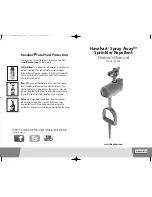
4-16
|
ni.com
Chapter 4
Analog Input
signal path as previously described using the same value resistor on both the positive and
negative inputs; be aware that there is some gain error from loading down the source, as shown
in Figure 4-7.
Figure 4-7.
Differential Connections for AC Coupled Floating Sources
with Balanced Bias Resistors
Using Non-Referenced Single-Ended (NRSE) Connections for
Floating Signal Sources
It is important to connect the negative lead of a floating signals source to AI GND (either directly
or through a resistor). Otherwise the source may float out of the valid input range of the NI-PGIA
and the DAQ device returns erroneous data.
Note
(NI USB-6341/6343/6346/6361/6363 BNC Devices)
To measure a floating
signal source on X Series USB BNC devices, move the switch under the BNC
connector to the FS position.
Figure 4-8 shows a floating source connected to the DAQ device in NRSE mode.
Figure 4-8.
NRSE Connections for Floating Signal Sources
All of the bias resistor configurations discussed in the
Using Differential Connections for
section apply to the NRSE bias resistors as well. Replace AI- with
AI SENSE in Figures 4-4, 4-5, 4-6, and 4-7 for configurations with zero to two bias resistors.
The noise rejection of NRSE mode is better than RSE mode because the AI SENSE connection
is made remotely near the source. However, the noise rejection of NRSE mode is worse than
DIFF mode because the AI SENSE connection is shared with all channels rather than being
cabled in a twisted pair with the AI+ signal.
–
+
AI GND
V
s
AC Co
u
pled
Flo
a
ting
S
ign
a
l
S
o
u
rce
AI+
AI–
AI
S
EN
S
E
AC Co
u
pling
MIO X
S
erie
s
Device
–
+
AI GND
R
AI
S
EN
S
E
AI
V
s
Flo
a
ting
S
ign
a
l
S
o
u
rce
MIO X
S
erie
s
Device
Summary of Contents for PCIe-6323
Page 1: ...PCIe 6323...
















































